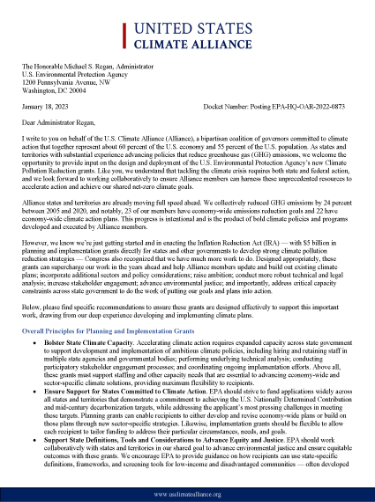Home / U.S. Climate Alliance Provides Input on Design and Deployment of EPA Climate Pollution Reduction Grants

Tags
- Letter
U.S. Climate Alliance Provides Input on Design and Deployment of EPA Climate Pollution Reduction Grants
January 18, 2023
As states and territories with substantial experience advancing policies that reduce greenhouse gas (GHG) emissions, we welcome the opportunity to provide input on EPA’s design and deployment of new Climate Pollution Reduction grants under the Inflation Reduction Act (IRA). Tackling the climate crisis requires both state and federal action and the Alliance looks forward to working collaboratively with the Administration to ensure our states can harness these unprecedented resources to accelerate action and achieve our shared net-zero climate goals.
Designed appropriately, these grants can supercharge our work in the years ahead and help Alliance members update and build out existing climate plans; incorporate additional sectors and policy considerations; raise ambition; conduct more robust technical and legal analysis; increase stakeholder engagement; advance environmental justice; and importantly, address critical capacity constraints across state government to do the work of putting our goals and plans into action.
About the Alliance
Launched in 2017 by the governors of Washington, New York, and California to help fill the void left by the U.S. federal government’s withdrawal from the Paris Agreement, the Alliance has grown to include 24 governors from across the U.S. representing approximately 60 percent of the U.S. economy and 55 percent of the U.S. population. Governors in the Alliance have pledged to collectively reduce net greenhouse gas emissions by at least 26-28 percent by 2025, 50-52 percent by 2030, and 61-66 percent by 2035, all below 2005 levels, and collectively achieve overall net-zero greenhouse gas emissions as soon as practicable, and no later than 2050.
The Alliance’s states and territories continue to advance innovative and impactful climate solutions to grow the economy, create jobs, and protect public health, and have a long record of action and results. In fact, the latest data shows that as of 2023, the Alliance has reduced its collective net greenhouse gas emissions by 24 percent below 2005 levels, while increasing collective GDP by 34 percent, and is on track to meet its near-term climate goal of reducing collective greenhouse gas emissions 26 percent below 2005 levels by 2025.
###